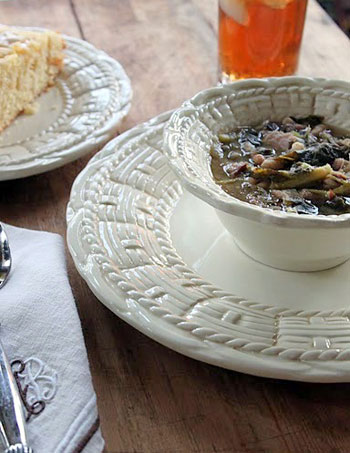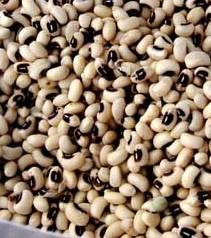“Eat poor that day, eat rich the rest of the year… Rice for riches and peas for peace.” – Old Southern saying for New Year’s Menu
 Collard greens, black eyed peas, cornbread and pork are the foodstuffs of the South, rich in legend, lore, and superstition. Money or not, every Southern family I know dines on these same vittles for their New Year’s supper. Not too poor of eating if I say so myself.
Collard greens, black eyed peas, cornbread and pork are the foodstuffs of the South, rich in legend, lore, and superstition. Money or not, every Southern family I know dines on these same vittles for their New Year’s supper. Not too poor of eating if I say so myself.
According to this Farmer, the New Year’s Day menu is a Southern supper at its finest. Steeped in tradition, flavored with history, and doused with a touch of superstition, this meal encompasses the South’s ebb and flow of classicism and eccentricity–a meal of our heritage. Here in America’s Deep South, the cultures of Europe, Africa and the Native Americans combine with their respected refinements and sentimentalities making this meal fit to usher in a new year.
Growing up in rural Middle Georgia, we knew our food’s legacy before it arrived on our tables. This Farm to Table movement of late has always been the custom for those of us raised in a more bucolic fashion. We know our farmers and growers. In his blessings before a meal, my brother-in-law’s father always gives thanks for “not only the hands that prepared the food but grew it as well...” whereas our New Year’s meal is of no exception. This is a meal seeking to begin the New Year with the blessings of life. Binding Southern commonality, our New Year’s meal is the food of the people, regardless of class, who eat will eat “poor” (common food) so we may eat “rich” (eat well) for the remainder: farm to table is as rich as they come.
Pork, in various forms, is used throughout the meal. The noble pig moves forward in life, progressing in its rooting for food, finding truffles and treasures of nourishment, while a chicken scratches backward for food. This old Southern axiom begins to shed some light on the development of our traditions and superstitions for New Year’s cuisine. We prefer to move forward as well, thus the basis Sus domestica’s appeal–why we eat pork on New Year’s Day and not chicken.
Braised or grilled sausage seasoned with herbs, spices, and other local flavor; roasted tenderloins sliced into medallions and served with biscuits; or chops barbequed and smoked with oak, pecan, or hickory wood–pork generally takes the lead role as main dish for a Southern New Year’s Day. What better way to start the New Year than with a pig–the mark of a year to come that is full of promise. A good pig can feed a family for months, and as for the better part of our country’s (and our world’s history for that matter) can attest, a pig with which to commence forward into the new year is a very good sign.
 As we progress, good fortune and its accoutrements, luck, money, health and wealth, shall hopefully be at our side. Black eyed peas, collard greens, cornbread, and Hoppin’ John, a Southern staple, shall be served across the Deep South on New Year’s Day and throughout the year. A mix of rice, dried peas or beans (usually black eyed peas), and some pork, this dish is more so a slice of Southern history.
As we progress, good fortune and its accoutrements, luck, money, health and wealth, shall hopefully be at our side. Black eyed peas, collard greens, cornbread, and Hoppin’ John, a Southern staple, shall be served across the Deep South on New Year’s Day and throughout the year. A mix of rice, dried peas or beans (usually black eyed peas), and some pork, this dish is more so a slice of Southern history.
Some of the finest rice in the South, Carolina Gold, was grown (and still is) in the Low Country. From Savannah upwards through coastal Carolina, this rice was a major cash crop in antebellum years–a doyenne of our lifeblood foodstuffs. After the Civil War, the Gulf States became major rice growers as well as the Mississippi River marshes of Arkansas. We Southerners eat many dishes over rice as a result. African and Caribbean influences further ensured the grain’s presence on our culinary tableaux, Hoppin’ John, Dirty Rice, and Jambalaya thus becoming ensconced into our heritage. For New Year’s Day, Hoppin’ John will be the dish du jour, bringing the progressive representation of pork with luck from the black eyed peas and brought together with a common grain that has fed us and much of the world for years. Rice for riches–its plentiful grains in hope will garner plenty for us as well.
Another Southern standard for New Year’s Day is Lucky Money. Combining black eyed peas with collard greens ensures luck and the hope of green–economic fortune. Seasoned with pork, may it be fatback, streak-o-lean, jowels, or back meat, this dish is another all encompassing way of bringing the greatest of expectations to the table for the New Year. Lucky Money, with its pot liquor, should be eaten with cornbread–crackling, corn pones, or skillet–whatever will allow you to sop up the liquor or flavor left in the pot after cooking the greens and meat. Sop it up indeed, for the cornbread represents gold and will continue your meal’s countenance to send you into the New Year with good fortune as your guide. Freeze your leftovers and make a delicious soup later on that will fill you again with the hope of goodness for a new year!
James T. Farmer III was born and raised in Georgia, where he continues to live and work as a landscape designer. He shares his love of food, flowers and photography on his blog All Things Farmer.

